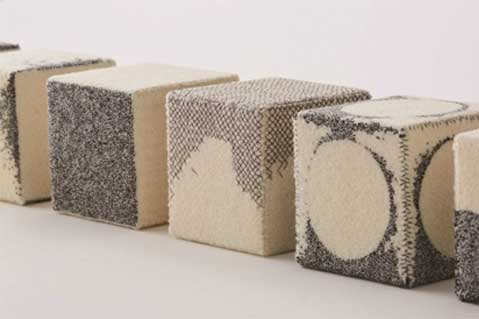May 31, 2017
Artist Plays With Embroidered Cubes
Richard McVetis especially enjoys borrowing images and patterns from everyday life and reconstructing them through embroidery.

For London-based multimedia artist Richard McVetis, a childhood fascination with pen-and-paper drawing has morphed into an eclectic collection of hand-embroidered, one-of-a-kind creations.
“Embroidery, for me, has become an extension of this exploration of surface through rendering,” McVetis observes, “substituting the ink for thread and the paper for fabric. The subtlety and dimension of stitch continue to fascinate me. When I’m stitching, I’m endeavoring to recreate the flatness of pen on paper.”
McVetis especially enjoys borrowing images and patterns from everyday life and reconstructing them through embroidery. “These patterns are part of your everyday, a place you pass routinely, the metal tread of a station entrance or the shadow created by the morning sunlight,” he says. “London is full of these moments, beautiful and unnoticed. These moments are punctuations of time; slowing me down in what is quite a fast-paced way of life.”
The unique artist’s process involves “taking notice of these, removing them from their context, elevating the mundane to a higher status.”
Among his best-known works is Variations of a Stitched Cube, a group of 60 hand-embroidered cubes, each featuring a different decoration. “The cubes show time, an ever-present invisible force, through form as both logical and playful,” the artist says, “starting with the first cube at one hour of stitching and finishing on the sixtieth and final cube with 60 hours of stitching.”
For McVetis, the precision of hand embroidery helps him to slow down and collect his thoughts, and allows for an intimate relationship with the work. He describes his creative process as “a bit all over the place,” noting that often, inspiration hits after seeing something interesting, and he starts to stitch or draw immediately.
“The embroidered cubes, the compositions, constellations and arrangements I create,” he explains, “directly reference the urban grid and my transient relationship to the built environment.”
